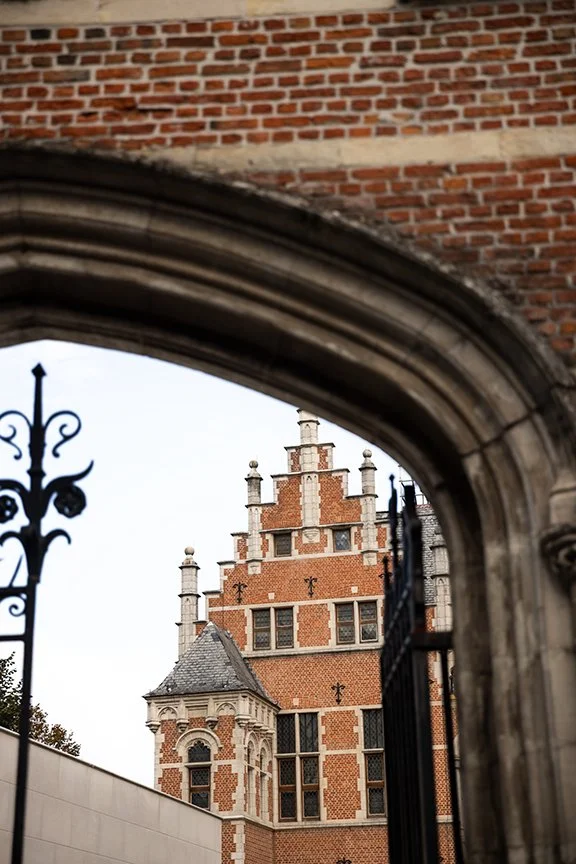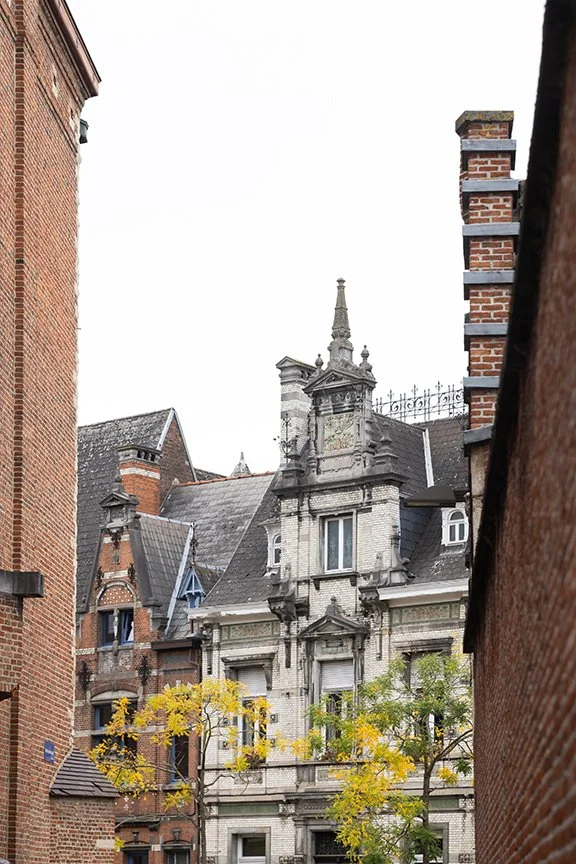Mechelen: Belgium's Best-Kept Secret
1. Restaurant 't Ankertje aan de Dijle (The Anchor on the Dijle), located at Vismarkt 20 | 2. Door on Hoviusstraat | 3. Hof van Savoye (Palace of Margaret of Austria or the Court of Savoy) is an early 16th-century building located at Keizerstraat 20 | 4. St. Rumbold's Cathedral and the Statue of Margaret of Austria
The small alleys of the Groot Béguinage: 1. Lovely window scene | 2. Begijnhofkerk as seen from Krankenstraat | 3. Sint Donatus House at Krommestraat 3 | 4. Door on Krankenstraat
Mechelen remains an overlooked treasure in Belgium's Flemish Region, nestled within the province of Antwerp. This compact city rarely makes it onto visitors' Belgian itineraries, which is a shame. As the former capital of the Dukes of Burgundy, Mechelen boasts remarkable historical importance and stunning architecture. Its picturesque streets and centuries-old buildings make it a perfect choice for a visit. While Mechelen offers plenty of contemporary attractions, we came specifically to explore its historic quarters and, most importantly, the béguinages (historic areas established in the 13th century for beguines, women who lived like nuns without taking formal vows).
1. The Grote Markt (Grand Market Square) | 2. Staircase in the Hof van Savoye | 3. Inside the Het Kunstuur Café at Minderbroedersgang 4 | 4. Grote Markt
Mechelen sits just 14 minutes from Brussels by train, making it an easy day trip from the capital. We arrived early and walked about 10 minutes from Mechelen-Nekkerspoel station to the city center. Like most Belgian towns, Mechelen's church steeples - particularly St. Rumbold's Cathedral - rise above the rooftops and point you toward the historic heart.
This was part of a Belgium trip with my sister, her husband, and their daughter. Fortunately, we all travel well together and share similar ideas about what makes good sightseeing. We reached the Grote Markt, a spacious square surrounded by guild houses and cafés. The morning was quiet, perfect for taking in the architecture and soaking up the relaxed atmosphere. After stopping for coffee and breakfast at one of the terrace cafés, we headed into the surrounding streets to explore. Laura had some screenshots of blog posts of some sights she wanted to see, so the afternoon turned into a bit of a treasure hunt, looking for the small Béguinage alleys she’d read about. Mechelen turned out to be perfect for aimless wandering - narrow lanes, quiet canals, and centuries-old brick buildings around every corner. This small town turned out to be one of our favorites on this trip.
1. Hof van Savoye | 2. Door in the Béguinage Church on Begijnenkerhof | 3. The De Noker houses the administrative offices of Mechelen's hospitals, located at Nokerstraat 4 | 4. Stairwell at the Hof van Savoye
HISTORIC MECHELEN & THE GROOT MARKT
BREWERY HET ANKER
A historic brewery located in the Groot Béguinage, where beer has been brewed since the Middle Ages.
DILJEPAD
The Dijle Path is a modern floating walkway. While not technically historic, it winds through some of Mechelen's most atmospheric waterside areas. Following the banks of the Dijle River between Haverwerf and Kruidtuin, this scenic route takes you past historic buildings, charming bridges, and beautiful medieval architecture reflected in the calm waters.
Along the way, you'll discover views of the Groot Béguinage, old merchant houses, and beautifully restored former industrial buildings. Historic quays and waterfront structures reveal why Mechelen was once an important trading port, offering a peaceful perspective on the city's rich maritime heritage.
GROTE MARKT
The grand square is surrounded by elegant merchant houses and dominated by St. Rumbold's Cathedral, with the magnificently Gothic Town Hall serving as its centerpiece. On Saturdays, the space comes alive with bustling market stalls.
HOF VAN BUSLEYDEN
A stunning Burgundian Renaissance palace that now houses Mechelen's city museum.
HOFF VAN SAVOYE (COURT OF SAVOY)
The Court of Savoy (or the Palace of Margaret of Austria) is a beautiful Renaissance building that now houses the Court of Appeal. Built in the early 16th century, it served as the residence of Margaret of Austria, regent of the Netherlands, who made Mechelen the capital of the Burgundian Netherlands from 1507 to 1530.
During her regency, the palace became a center of European politics, art, and culture, attracting leading artists and scholars. Margaret's court transformed Mechelen into one of the most important cities in Europe, and the palace stands as a testament to this golden age. It was sad to see so many of the formal garden shrubs dry and dead, but it was still worth a visit.
SINT-ROMBOUTSTOREN
St. Rumbold's Tower is Mechelen's iconic 97-meter landmark and a UNESCO World Heritage Site. Climb the 538 steps for breathtaking panoramic views, passing the famous carillon of 49 bells along the way - Mechelen is one of the world's premier carillon cities.
Originally planned to reach 167 meters, construction stopped due to financial constraints, giving the tower its distinctive flat-topped appearance. Whether you climb to the top or admire it from below, it's an essential Mechelen experience.
1. Twaalf-Apostelenstraat | 2. Signpost showing landmarks, near Schepenhuis | 3. The Hof van Busleyden Museum at Frederik de Merodestraat 65 | 4. Doorway at the Hof van Savoye in Mechelen
MECHELEN’S BÉNGUINAGES
What is a béguinage? A béguinage served as a walled, women-only community that emerged during the Crusades to shelter women left behind during wartime. Unlike nunneries that catered exclusively to the wealthy, béguinages accepted women from every social background - though men were entirely excluded.
What set beguines apart from nuns was their freedom from permanent vows of poverty, obedience, and chastity.
These communities, which began appearing in the 13th century and flourished during the 15th century, typically featured clusters of small houses or apartments encircled by walls and gates. Inside, residents shared access to a chapel, gardens, and communal spaces where they dedicated themselves to prayer and charitable work—maintaining a religious life without the rigid hierarchy of traditional monasteries
1. The 12th-century De Beyaert Town House, located at Grote Markt 1, now houses the post office | 2. Jezuspoort (Jesus' Gate) 1 and 3, in the Groot Béguinage of Mechelen | 3. Part of the béguinage, on Jezuspoort | 4. Beautiful door in Mechelen
Mechelen is unique in Belgium for having two béguinages, both recognized as UNESCO World Heritage Sites. Notably, the brewery building once functioned as the béguinage hospital.
GROOT BEGIJNHOF (THE GRAND BÉGUINAGE)
Founded around 1240, this is the larger and more famous of the two. It's essentially a small town with over 100 houses, cobblestone streets, gardens, and the Church of St. Alexis and St. Catherine. The brick buildings with stepped gables date from the 16th to 18th centuries, creating a remarkably tranquil enclave along the Dijle River.
KLEIN BEGIJNHOF (THE SMALL BÉGUINAGE)
Located closer to the city center near St. Rumbold's Cathedral, the Small Béguinage is more compact and intimate. Though smaller in scale, it retains the characteristic peaceful atmosphere with its whitewashed houses, small gardens, and quiet courtyards. This béguinage also dates from the medieval period and showcases similar architectural styles.
Today, both remain residential areas, carefully preserved and still inhabited, offering visitors a window into this distinctive aspect of Low Countries religious and social history.
Start your visit to the beguinages from the Grote Markt and head towards Sint-Katelijnestraat, where you'll find the Grand Béguinage on your left and the Small Béguinage on your right.
1. Historical building at Frederik de Merodestraat 61 | 2. The IJzerenleen boasts imposing façades and lovely shops | 3. Hoviusstraat is where you’ll find the béguinage as well as Het Anker Brewery in the Groot Begijnhof | 4. Door at the De Borght castle at Lakenmakersstraat 4
1. Door on Sint Janskerk | 2. Hof van Savoye | 3. De Cellekens (The Cells) was originally a charitable institution that took in needy women; the property has been transformed into a centre for art and culture | 4. Door on Nonnenstraat in the Groot Begijnhof
PLANNING YOUR VISIT
HOW TO GET HERE
By Train From Brussels:
Station Brussel-Schaarbeek - Via SNCB. SNCB has a great app, and tickets can easily be purchased through the app or even in advance online.
Brussels-North - Via Nederlandse Spoorwegen (NS)
TOURISM INFORMATION
Visit Mechelen
Lots of helpful information, including a map of the city.
Location: Vleeshouwersstraat 6
1. Decor inside the Het Kunstuur Café | 2. Restaurant Madrid as viewed while walking along the Dijle River on the Dijlepad walkway - photo by Laura Woodard | 3. Museum Hof Van Vusleyden | 4. Door on Nokerstraat
1. Sint-Pieters-en-Pauluskerk (Church of Saints Peter and Paul) | 2. Brasserie Restaurant Carlton at the Grote Markt | 3. The Melaan is a revitalized stream and waterfront area that was once a filled-in street and now features walking and cycling paths, bridges, and water features | 4. Door on Toegangspoortx in the Groot Begijnhof
Exploring the Groot Béguinage: 1. Jezuspoort 5 | 2. Sint Alexiusstraat | 3. Twaalf Apostelenstraat | 4. Hoviusstraat
1. The Dijlepad, a floating scenic riverside path that runs along the Dijle River | 2. A door at the Mechelen City Hall | 3. A Pigeon nesting in the walls along the Dijlepad | 4. Bar Klak, a cafe located in the Grote Markt - the building is also known as the Mechelen Schappenhuis, or Aldermen's House
Beautiful doors in the Groot Béguinage: 1. Sint Donatus House at Krommestraat 3 | 2. Sint Alexiusstraat | 3. Moreelstraat | 4. Moreelstraat






















































The Grote Markt in Mechelen, Belgium